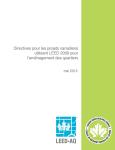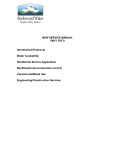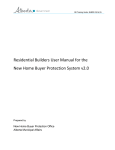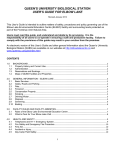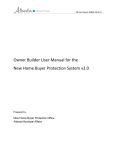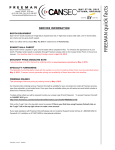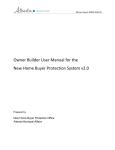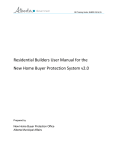Download tool for costing sustainable community planning: user guide
Transcript
Canadian Mortgage and Housing Corporation TOOL FOR COSTING SUSTAINABLE COMMUNITY PLANNING: USER GUIDE DRAFT SEPTEMBER 2006 IBI GROUP DRAFT TABLE OF CONTENTS 1. INTRODUTION .........................................................................................................................1 1.1 What is the Tool for Costing Sustainable Community Planning? .................................................... 1 1.2 How Does this User Guide Work? ....................................................................................................... 2 2. INSTALLING AND OPENING THE TOOL...............................................................................2 3. TOOL BASICS .........................................................................................................................3 3.1 Structure ................................................................................................................................................ 3 3.2 Navigation .............................................................................................................................................. 4 4. UNDERSTANDING SCENARIOS............................................................................................6 4.1 Choosing a Scenario............................................................................................................................. 6 4.2 Creating a New Scenario ...................................................................................................................... 7 4.3 Deleting a Scenario ............................................................................................................................... 7 5. SPECIFYING COSTING VARIABLES.....................................................................................8 6. SPECIFYING REVENUE VARIABLES..................................................................................10 7. ENTERING DEVELOPMENT CHARACTERISTICS .............................................................10 L an d U se and L o ca t io n a l C h a ra ct e ri st ic s . . . . . . . . . . . . . . . . . . . . . . . . . . . . . . . . . . . . . . . . . . . . . . . . . . . . . . . . . . . . . 1 0 D e ve lo p m ent T yp e . . . . . . . . . . . . . . . . . . . . . . . . . . . . . . . . . . . . . . . . . . . . . . . . . . . . . . . . . . . . . . . . . . . . . . . . . . . . . . . . . . . . . . . . . . . . . . 1 1 D e ve lo p m ent D en sit i es . . . . . . . . . . . . . . . . . . . . . . . . . . . . . . . . . . . . . . . . . . . . . . . . . . . . . . . . . . . . . . . . . . . . . . . . . . . . . . . . . . . . . . . 1 2 D em o g r aph ic A s sum p t io n s . . . . . . . . . . . . . . . . . . . . . . . . . . . . . . . . . . . . . . . . . . . . . . . . . . . . . . . . . . . . . . . . . . . . . . . . . . . . . . . . . 1 2 H a rd In f r a st r u ct u re . . . . . . . . . . . . . . . . . . . . . . . . . . . . . . . . . . . . . . . . . . . . . . . . . . . . . . . . . . . . . . . . . . . . . . . . . . . . . . . . . . . . . . . . . . . . 1 2 T r ans it Inf ras t ru c t u re . . . . . . . . . . . . . . . . . . . . . . . . . . . . . . . . . . . . . . . . . . . . . . . . . . . . . . . . . . . . . . . . . . . . . . . . . . . . . . . . . . . . . . . . . 1 3 September 2006 8. SPECIFYING ALLOCATION OF COSTS ..............................................................................13 9. EXPLORING AND INCORPORATING GREEN INFRASTRUCTURE ALTERNATIVES ....................................................................................................................13 10. ENTERING COST SAVINGS .................................................................................................16 11. ADDING USER-DEFINED COSTS AND REVENUES ..........................................................16 Page i. IBI GROUP DRAFT TABLE OF CONTENTS (CONT’D) 12. VIEWING RESULTS...............................................................................................................17 12.1 Hard Infrastructure and Municipal Services ..................................................................................... 17 12.2 Revenues and Cost Recovery............................................................................................................ 19 12.3 Private and External Costs................................................................................................................. 20 12.4 Printing Results................................................................................................................................... 21 13. September 2006 CONDUCTING FURTHER ANALYSIS ..................................................................................21 Page ii. IBI GROUP DRAFT CANADIAN MORTGAGE AND HOUSING CORPORATION TOOL FOR COSTING SUSTAINABLE COMMUNITY PLANNING: USER GUIDE 1. INTRODUTION 1.1 What is the Tool for Costing Sustainable Community Planning? There has been much debate in recent years about the costs of development, both in terms of the true costs of different development forms as well how the costs of development are shared between the public, the private sector and the environment. There is mounting evidence that more compact, mixed-use development is a more cost-efficient and environmentally sustainable form of development than low-density suburban development. However, there are very few readily available tools to demonstrate the degree to which this is true, or to effectively compare different types of development. The Tool for Costing Sustainable Community Planning (henceforth, “The Tool”) was created to allow a user to estimate the major costs of community development, particularly those that change with different forms of development (e.g., linear infrastructure), and to compare alternative development scenarios. The Tool is geared towards estimating “planning-level” costs and revenues associated with the residential component of a development, although financial impacts of commercial and other types of development can be incorporated provided that infrastructure requirements are specified correctly. The Tool is well suited to assessing development projects ranging in size from a collection of houses, to a block-by-block infill development, to an entire subdivision. A good measure of the applicability of the Tool to a given project is whether or not alternatives can be conceived that would result in significantly different densities or infrastructure requirements, or make use of different green infrastructure alternatives. The Tool includes costing variables to allow the user to estimate costs for the following major categories: • Hard Infrastructure, including roads, sewers, stormwater facilities, schools and recreation centres; • Municipal Services, including transit services, school transit, fire services, police services and waste management services; • Private User Costs, including driving costs and home heating costs; • External Costs, including air pollution, climate change and motor vehicle collisions; and • Green Infrastructure alternatives. Revenues from development charges, property taxes, and user fees are also estimated. Users can easily estimate and compare costs and revenues among a variety of development scenarios. This tool allows users to consider the lifecycle costs of development, which are calculated over a 75year time horizon. Lifecycle costs include initial capital, annual operating, and replacement costs. CMHC and the Tool Developers assume no responsibility for the use of this Tool or any changes made by users. September 2006 IBI GROUP DRAFT CANADIAN MORTGAGE AND HOUSING CORPORATION TOOL FOR COSTING SUSTAINABLE COMMUNITY PLANNING: USER GUIDE 1.2 How Does this User Guide Work? This User Guide provides guidance on all aspects of Tool operation from installation, to development of scenarios, to outputting results, to viewing internal calculations, and conducting further analysis. The Guide can be read from “cover to cover” or can be referred to as necessary as specific questions arise. The purpose of this guide is not to provide detailed information on the assumptions and sources used in the development of default unit costs or built-in development scenarios. Further documentation, to be included in later versions of the Tool will include this detailed information. The User Guide is structured into the following sections: • Installing and opening the Tool • Tool basics: structure and navigation • Understanding scenarios • Specifying costing variables • Specifying revenue variables • Entering development characteristics • Specifying allocation of costs • Exploring and incorporating green infrastructure alternatives • Entering Cost Savings • Adding user-defined costs and revenues • Viewing results • Further analysis 2. INSTALLING AND OPENING THE TOOL The Tool is developed in Microsoft Excel™, a software application familiar to most of its users, and is thus expected to be simple to install, open, and operate. To install and launch the Tool, follow the steps below: 1. Ensure Microsoft Excel™ is installed on your computer. 2. Save a copy of Tool to the desired location on your computer as well as a backup copy. 3. Open Microsoft Excel™ and set the Macro Security Level to “Medium” or “Low” (Tools>>Macro>>Security). If the Macro Security Level is “High”, the Tool will not run properly. September 2006 Page 2 IBI GROUP DRAFT CANADIAN MORTGAGE AND HOUSING CORPORATION TOOL FOR COSTING SUSTAINABLE COMMUNITY PLANNING: USER GUIDE 4. Run the Tool file. If you are prompted regarding the security of macros in the file, select “Enable Macros”. The Main Menu of the Tool will then display. 3. TOOL BASICS 3.1 Structure The Tool is based on a step-by-step process consisting of up to nine steps as detailed in the main menu (see figure below). At a minimum, users must select or enter a new scenario (Step 1) and review or modify the development characteristics (Step 4). Users also have the option of changing assumptions on unit costs (Step 2), revenue variables (Step 3) and the allocation of costs (Step 5). Additionally, the Tool provides the flexibility to incorporate the costs of green infrastructure alternatives (Step 6) and user defined costs (Step 7). Step 8 provides the ability to account for in place infrastructure and resulting cost savings. Finally, Step 9 presents the results in various output formats. September 2006 Page 3 IBI GROUP DRAFT CANADIAN MORTGAGE AND HOUSING CORPORATION TOOL FOR COSTING SUSTAINABLE COMMUNITY PLANNING: USER GUIDE 3.2 Navigation Navigation through the nine steps is facilitated by the Main Menu. After completing a step, users can simply select the button at the top right of each screen to go back to the Main Menu and proceed to the next step, review previous steps, or proceed to the results. In each of the steps that change input, users have the option to Save Changes to the input or revert to saved values for the current scenario, using the Revert Changes button at the top of each step. Users are not permitted to change parameters for built-in scenarios. If users exit a step without saving changes, values are replaced with the most recent saved values upon returning to the Main Menu. Note that in the Draft Tool Green Infrastructure Alternatives are not saved together with the scenarios and only the most recent green infrastructure inputs are saved upon saving the Excel spreadsheet. September 2006 Page 4 IBI GROUP DRAFT CANADIAN MORTGAGE AND HOUSING CORPORATION TOOL FOR COSTING SUSTAINABLE COMMUNITY PLANNING: USER GUIDE After completing a step, using the buttons at the top right of each screen, users can Save Changes or Revert Changes to previously saved values, and then go back to the Main Menu. A number of visual queues are provided within the Tool to assist users: ) Provides reference to additional resources. Yellow Denotes cells that can be changed by users. Grey September 2006 Provides specific information on the input assumptions, type of data to be entered, or cautionary notes. Denotes cells that may be changed, but caution is advised since values represent common accepted values Page 5 IBI GROUP DRAFT CANADIAN MORTGAGE AND HOUSING CORPORATION TOOL FOR COSTING SUSTAINABLE COMMUNITY PLANNING: USER GUIDE 4. UNDERSTANDING SCENARIOS A scenario represents a unique combination of both development characteristics and costing variables and is the basic structure used for evaluation and comparison. The first step in the Main Menu is to Create/Modify/View or Delete Scenarios. 4.1 Choosing a Scenario The Tool contains six built-in scenarios ranging from High-Density, Mixed-Use in the Inner area to Low-Density, Residential in the Outer Area as described below. These scenarios are provided to help users learn how to use the Tool, illustrate a range of possible inputs, and provide a basis for user-defined scenarios. Note that costing and revenue variables are consistent across the build-in scenarios. To choose one of the built-in scenarios, simply select one from the appropriate drop-down menu in the Step 1 screen. The scenario displayed in this field is always the active scenario. Select the “Done” button in the upper right of the screen, which will return you to the Main Menu. The scenario’s costing, revenue, development, and other characteristics can then be viewed by selecting the appropriate button in the main menu. September 2006 Page 6 IBI GROUP DRAFT CANADIAN MORTGAGE AND HOUSING CORPORATION TOOL FOR COSTING SUSTAINABLE COMMUNITY PLANNING: USER GUIDE 4.2 Creating a New Scenario New scenarios are created as modifiable copies of existing user-defined or built-in scenarios. To create a new scenario, navigate to the Step 1 screen and proceed to: 1. Using the drop down box, choose the existing scenario that best defined the characteristics of the development you want to explore. 2. In the second field, enter the name for the new scenario. 3. Select the button, “Save New Scenario” (to do this, you will first need to select an empty cell away from the field in which you entered the scenario name). The new scenario automatically becomes the active scenario. 4. To make modifications to your new scenario, select the “Done” button in the upper right of the screen, which will return you to the Main Menu, and proceed to appropriate screens. There is no limit to the number of new scenarios that can be completed. However, in order to keep the file size manageable, it is recommended not to create more than 15 new scenarios in the same file. Additional scenarios can be created by saving the spreadsheet Tool as a new file. 4.3 Deleting a Scenario To delete a scenario, navigate to the Step 1 screen and proceed to: 1. Using the drop down box, choose the scenario that you want to delete. Built-in scenarios cannot be deleted. September 2006 Page 7 IBI GROUP DRAFT CANADIAN MORTGAGE AND HOUSING CORPORATION TOOL FOR COSTING SUSTAINABLE COMMUNITY PLANNING: USER GUIDE 2. Select the “Delete Scenario” button select “Yes” in response to the deletion confirmation question. 5. SPECIFYING COSTING VARIABLES Step 2, “Specify Costing Variables” allows the user to modify the unit cost assumptions related to hard infrastructure, municipal services, private costs, and external costs. The user can also modify the interest rate for amortizing capital costs and set capital and operating cost escalation factors to account for geographic, climatic or other unique circumstances. ) Details about each specific cost are provided in the Tool using the symbol. As discussed above, all yellow cells denote cells that can be changed by the user. Grey cells denote cells that may be changed, but caution is advised, since the values represent commonly accepted levels. After completing this step, select the button at the top right of the screen to go back to the Main Menu and proceed to the next step, review previous steps, or proceed to the results. If you change any costing variables, you can select the button to “Save Changes” to the input or revert to save values for the current scenario, using the “Revert Changes” button at the top right of the screen. If you exit a step without saving changes, values are replaced with the most recent saved values upon returning to the Main Menu. All costing variables are summarized in the table below. Category General Cost Assumptions Cost Type Interest Rate for Amortizing Capital Costs Cost Escalation Factor Roads and Local Municipal Services – Capital Costs Regional Municipal Services – Capital Costs Local Storm Water Management – Capital Costs Hard Infrastructure Road - Operating Costs Water Treatment and Distribution Operating Costs Variable Capital Cost Factor Operating Cost Factor Basic Roadworks (7 Roadway Types) Sidewalks Local Water Distribution Local Sanitary Sewers Local Storm Sewers Water Distribution Sanitary Sewer Storm Sewer Unit % $/m $/m $/m $/m $/m $/m of trunk pipe $/m of trunk pipe $/m of trunk pipe Retention Pond $/gross ha Local Roads Collector Roads Arterial Roads Traditional Suburban Development Medium Density Development Higher Density Development $/m $/m $/m $/household $/household $/household $/household $/m of trunk pipe $/student $/student $/student $/household $/household Wastewater Treatment – Operating Costs Sanitary and Storm Sewers – Operating Costs Capital Costs Schools Operating Costs School Bus Capital Costs Capital Costs Recreational Facilities Operating Costs September 2006 Page 8 IBI GROUP DRAFT CANADIAN MORTGAGE AND HOUSING CORPORATION TOOL FOR COSTING SUSTAINABLE COMMUNITY PLANNING: USER GUIDE Category Cost Type Transit Municipal Services Fire Protection Police Services Waste Management Private Costs Private Vehicles Home Heating Variable Capital Costs Operating Costs Capital Costs Operating Costs Capital Costs Operating Costs Operating Costs Annual Vehicle Ownership Costs Operating Costs Annual Home Energy Costs (3 dwelling types) Average Fuel Efficiency for Passenger Vehicles GHG Emissions Factor GHG Emission Cost Climate Change and Air Pollution External Costs Motor Vehicle Collisions Local Roads External Roads Water Distribution Sanitary Sewer Replacement Period for Capital Assets Storm Sewer Schools Recreational Facilities Bus Transit Fire Service Vehicles Police Service Vehicles September 2006 Air Pollutant Emissions Factor (5 variables for Volatile Organic Compounds, Carbon Monoxide, Nitrogen Oxides, Sulphur Oxides, Particulate Matter less than 10 microns, respectively) Emission Costs (5 variables for pollutants above) Fatal Collision Rate Fatal Cost Injury Collision Rate Injury Cost Property Damage Collision Rate Property Damage Cost Years for Replacement Replacement Cost Years for Replacement Replacement Cost Years for Replacement Replacement Cost Years for Replacement Replacement Cost Years for Replacement Replacement Cost Years for Replacement Replacement Cost Years for Replacement Replacement Cost Years for Replacement Replacement Cost Years for Replacement Replacement Cost Years for Replacement Replacement Cost Unit $/bus $/vehicle service hour $/household $/household $/household $/household $/household $/vehicle/annum $/km $/household L/100 km g/L fuel $/tonne of CO2 equivalents g/L fuel $/tonne collisions/VKT $/collision collisions/VKT $/collision collisions/VKT $/collision years % of original capital cost Years % of original capital cost Years % of original capital cost Years % of original capital cost Years % of original capital cost Years % of original capital cost Years % of original capital cost Years % of original capital cost Years % of original capital cost Years % of original capital cost Page 9 IBI GROUP DRAFT CANADIAN MORTGAGE AND HOUSING CORPORATION TOOL FOR COSTING SUSTAINABLE COMMUNITY PLANNING: USER GUIDE 6. SPECIFYING REVENUE VARIABLES Step 3, “Specify Revenue Variables” allows the user to modify the revenue assumptions related to development charges, property taxes, and user charges ) Details about each specific revenue variable are provided in the Tool using the symbol. As discussed above, all yellow cells denote cells that can be changed by the user. Grey cells denote cells that may be changed, but caution is advised, since the values represent commonly accepted levels. After completing this step, select the button at the top right of the screen to go back to the Main Menu and proceed to the next step, review previous steps, or proceed to the results. If you change any revenue variables, you can select the button to “Save Changes” to the input or revert to save values for the current scenario, using the “Revert Changes” button at the top right of the screen. If you exit a step without saving changes, values are replaced with the most recent saved values upon returning to the Main Menu. All revenue variables are summarized in the table below. Category Development Charges Property Taxes Revenue Type Variable $/unit Semi-Detached $/unit Rowhouse/Townhouse/Duplex $/unit Low Rise $/unit High Rise $/unit Average Assessment Value Single Detached $/unit Semi-Detached $/unit Rowhouse/Townhouse/Duplex $/unit Low Rise $/unit High Rise $/unit Property Tax Rate User Charges 7. Unit Single Detached % User charges not included in property taxes $ Transit Fare % Transit Costs Recovered Through Transit Fares ENTERING DEVELOPMENT CHARACTERISTICS Step 4, “Enter Development Characteristics” allows the user to specify development characteristics, such as land use, demographic assumptions, residential densities, and the amount of hard infrastructure required. When assessing different development types for a given plot of land, unit cost and revenue assumptions will generally remain consistent, so that the development characteristics will be the defining characteristics that lead to different costs and revenues between the scenarios. Thus, it is important to specify these characteristics as accurately as possible. Explanations for each development characteristics category are provided below. LAND USE AND LOCATIONAL CHARACTERISTICS Variable under this category related to the general locational and land use characteristics of the development and are used in the calculation of travel activity and related impacts as well as in the September 2006 Page 10 IBI GROUP DRAFT CANADIAN MORTGAGE AND HOUSING CORPORATION TOOL FOR COSTING SUSTAINABLE COMMUNITY PLANNING: USER GUIDE allocation of costs between residential and non-residential uses. These variable are defined, as follows: • Distance to Central Business District: The straight-line distance between the approximate centre of the development and the approximate centre of the nearest central employment area in kilometres. This variable is a significant determinant of travel activity. • Gross Land Area: The total area of the development in hectares, including any area, such as streams or other sensitive areas that will not be developed. • Percent Residential: Proportion of Gross Land Area that is designated for residential uses, including residential parcels, local roads, parks, schools, and other facilities integral to residential development. Setting this value will require some judgement. User should determine this percentage, while considering that this value is used as a scaling factor to estimate the proportion of infrastructure and municipal services costs associated with the residential component of the development. Cost for the “Residential Portion” are used to determine per household costs, which are used to compare the cost-efficiency of different developments (see Section 12, which discusses Step 9, “View Results”). Implicitly, this assumes that these costs vary proportionally with land allocation. This assumption is considered reasonable in most cases, but may be less accurate where there is a large difference in the intensity of development between residential and non-residential components of a development. As an example, consider a ten-hectare site, with the following land allocation: • 7 hectares dedicated to residential buildings, local roads, schools, and parks; • 1.5 hectares dedicated to local and regional commercial uses; • 1 hectare dedicated to regional arterial roads; and • 0.5 hectares undeveloped. Such a development would have a Gross Land Area of 10 hectares. Calculation of Percent Residential would require some judgement, particularly in the case of the regional arterial roads, which serve the local residential population as well as more regional traffic. Without further information, it is assumed that half of the land area for the regional arterial roads can be assumed a component of residential development. Thus, the Percent residential would be 75% (i.e. (7 + 1*0.5)/10). DEVELOPMENT TYPE This category requires the user to characterize the development as one of three types, which most represents the development under consideration: September 2006 • Compact development, retail services close by, bike lanes or trails available, grid network or continuous streets. • Medium density residential development with some ancillary commercial uses. Generally a continuous grid network with good transit service and potentially bike lanes. Page 11 IBI GROUP DRAFT CANADIAN MORTGAGE AND HOUSING CORPORATION TOOL FOR COSTING SUSTAINABLE COMMUNITY PLANNING: USER GUIDE • Primarily residential development built on closed network street patterns (e.g. cul-desacs) with limited transit accessibility and few or no bike lanes. This input is used by the Tool to assume approximate values for several variables, which play a minor role in the estimation of auto ownership. These variables include weekday transit service hours within a 1 kilometre radius, percent curvilinear road layout, and the ratio of bike lanes to road kilometres, among others. D E V E L O P M E N T D EN S I T I ES The number of residential units by housing type is required to determine many factors, such as the number of households and per household costs, revenues, population, and auto ownership and use, among others. The Tool considers five dwelling types: single detached, semi-detached, rowhouse/townhouse/ duplex, low rise, and high-rise. Each built-in scenario is the same size (i.e. 40 hectares), but has different breakdown of housing units by type. These values can be modified for new scenarios. A screenshot of the Development Densities input screen is shown below. As described in the user note to the right of the screenshot ( ), users must enter the number of housing units by type directly (column 4). To guide this input, users can specify the “Unit Type Breakdown” (column 2), and take the value from the “Approximate Units” field (column 3). This field calculates the number of units by housing type based on the calculation: Gross Land Area * Percent Residential * Typical Coverage * Unit Type Breakdown. All subsequent calculations are based on the number of units (Column 4). ) D E M O G R A PH I C A S S U M P T I O N S Demographic assumptions are important in calculations regarding auto ownership and use and school costs. Assumptions include the average household size by dwelling type, the number of adults per household, average household income, and the number of jobs within 5 kilometres of the development. Jobs within 5 kilometres of the development and the distance to the central business district should be calculated from a location, which is approximately in the centre of the development. HARD INFRASTRUCTURE The amount of required road, water, wastewater, and stormwater infrastructure determine much of the costs of the development. Due to possible differences in allocation of costs, road inputs are divided into internal and external road requirements. Internal road lengths can be specified in terms September 2006 Page 12 IBI GROUP DRAFT CANADIAN MORTGAGE AND HOUSING CORPORATION TOOL FOR COSTING SUSTAINABLE COMMUNITY PLANNING: USER GUIDE of seven different road types ranging from public laneways, to four-lane arterials, to user-specified facilities (i.e., user can create a new road type defined by its unit cost in Step 2). Internal water and sewer infrastructure requirements do not need to be specified as they are assumed to follow the internal road requirements. Water and sewer unit costs by road type are specified in the Revenue Variables sheet. Water and sewer infrastructure external to the development is identified explicitly, including the length of required trunk pipes for water distribution, storm sewers, and sanitary sewers, as well as the size of stormwater management pond required. TRANSIT INFRASTRUCTURE Public transit infrastructure is specified in terms of the vehicle service hours per capita and the number of buses required per 1000 vehicle service hours. Vehicle service hours per capita (or revenue service hours per capita) can be estimated from local results from your community. Contact your local transit agency or look to the Canadian Transit Fact Book published by the Canadian Urban Transit Association (http://www.cutaactu.ca/). 8. SPECIFYING ALLOCATION OF COSTS A key factor in determining the costs of a development is the question of who pays. Allocation of capital and operating costs associated with hard infrastructure and municipal services is specified in Step 5, “Allocation of Costs”. Users can specify how each cost is shared between four different partners: the developer, the municipality, the user, and an “Other” category. The cost allocation input screen is shown below. The default for each cost is to allocate 100% of the cost to the municipality. The user can modify this as appropriate, but should ensure that the total column for each cost sums to 100%. 9. EXPLORING AND INCORPORATING GREEN INFRASTRUCTURE ALTERNATIVES Step 6, “Green Infrastructure” allows the user to explore a wide variety of green infrastructure alternatives and estimate associated costs and revenues, in many cases. In this discussion, the term “green infrastructure” is used broadly to refer to all infrastructure components of a development that can enhance the environmental sustainability of the development relative to September 2006 Page 13 IBI GROUP DRAFT CANADIAN MORTGAGE AND HOUSING CORPORATION TOOL FOR COSTING SUSTAINABLE COMMUNITY PLANNING: USER GUIDE conventional approaches. Since costs and benefits associated with several green infrastructure alternatives, such as Tree Preservation, are highly variable and dependent on many factors, information on these alternatives is included to provide decision support, but costs and revenues cannot be estimated directly. The table below lists the green infrastructure alternatives considered in the Tool and whether associated costs can be estimated. Green Infrastructure Alternative Bicycle and Pedestrian Paths Permeable Pavement Exfiltration Trenches Stormwater Harvesting Green Roofs Rain Barrels Naturalized Landscaping District Heating and Cooling Photovoltaics Costs Estimate Available 3 3 3 3 3 3 3 3 3 Distributed Power Building Orientation and Design Traffic Calming Alternative Road Standards 3 3 Tree Preservation September 2006 Page 14 IBI GROUP DRAFT CANADIAN MORTGAGE AND HOUSING CORPORATION TOOL FOR COSTING SUSTAINABLE COMMUNITY PLANNING: USER GUIDE A separate screen is provided for each green infrastructure alternative, which can be reached from the Step 6 screen. Each specific screen has a similar layout, which consists of four sections: “General Description and Importance to Sustainability”, “Typical Costs”, Typical Savings”, and “Costs”, as shown in the screen for Naturalized Landscaping, to the right. Costs of the different green infrastructure alternatives are summarized in the Step 6 screen, as shown below. Total green infrastructure costs are carried forwarded to the Results screen and displayed in their own category. Note that inputted values and estimated costs for Green Infrastructure Alternatives are not saved together with the scenarios. Only the most recent green infrastructure inputs are saved upon saving the Excel spreadsheet Tool. September 2006 Page 15 IBI GROUP DRAFT CANADIAN MORTGAGE AND HOUSING CORPORATION TOOL FOR COSTING SUSTAINABLE COMMUNITY PLANNING: USER GUIDE 10. ENTERING COST SAVINGS Step 7, “Infrastructure Cost Savings” enables users to discount costs to account for infrastructure that may already be in place. Areas such as brownfields, for example, may have excess capacity to accommodate new growth without the need for additional infrastructure. Users can enter the proportion of infrastructure that already exists and is considered space capacity. Final costs will be multiplied by the difference between the percentage entered and 100%. Entering 0% means that no cost savings are incurred due to excess infrastructure and all costs are attributed to the development. 11. ADDING USER-DEFINED COSTS AND REVENUES The Tool includes many of the most common types of costs associated with a development. However, there may be other costs and revenues that users may wish to include such as: • Home construction costs; • Land costs; • Site remediation costs due to pre-existing environmental contamination; • Noise remediation; • Demolition costs; • Green Infrastructure Funds; • Brownfield redevelopment funds; • Revenues from sale of lands or other resources; or • Revenues from district energy production or other green ventures. Step 8, “User-Defined Costs and Revenues” any other miscellaneous initial capital costs, annual operating costs, or revenues. Revenues should be entered as an annual equivalent amortized over the lifecycle (i.e., 75 years). September 2006 Page 16 IBI GROUP DRAFT CANADIAN MORTGAGE AND HOUSING CORPORATION TOOL FOR COSTING SUSTAINABLE COMMUNITY PLANNING: USER GUIDE 12. VIEWING RESULTS Step 9, “View Results” allows users to view and print summaries of costs and revenues and compare results from different scenarios. As shown in the screenshot of the Results Navigation Window, below, users can be directed to result summaries and scenario comparisons under three categories: “Hard Infrastructure and Municipal Services”, “Revenues and Cost Recovery”, and “Private Costs and External Costs”. Directions for viewing the data and performing scenario comparisons are provided in the sections below. 12.1 Hard Infrastructure and Municipal Services Result Summaries Under the category of “Hard Infrastructure and Municipal Services”, the Tool generates tables and graphs summarizing initial capital costs, annual operating costs, and lifecycle costs. Lifecycle costs are expressed on an annual basis and are calculated as initial capital costs, annual operating costs, and replacement costs amortized over the 75-year time-horizon. Sample screenshots of these summaries are shown below. Summary tables subdivide costs into total development costs, residential costs, household costs, and percentage breakdown. Residential costs refer to the infrastructure and service costs associated with the residential portion of the development and are calculated as total costs multiplied the Percent Residential Land Area, specified in Step 4, “Enter Development Characteristics” (see Section 7). Household costs simply express the costs of the residential portion of the development on a per-household basis. For each cost summary, pie and bar charts provide a visual breakdown of hard infrastructure and municipal services costs. Note that due to the large magnitude of school operating costs, these costs are not included in the pie chart for annual operating costs. A “View Other Result” button below each of these charts allows the user to easily return to the Results Navigation Window and then view other results. September 2006 Page 17 IBI GROUP DRAFT CANADIAN MORTGAGE AND HOUSING CORPORATION TOOL FOR COSTING SUSTAINABLE COMMUNITY PLANNING: USER GUIDE September 2006 Page 18 IBI GROUP DRAFT CANADIAN MORTGAGE AND HOUSING CORPORATION TOOL FOR COSTING SUSTAINABLE COMMUNITY PLANNING: USER GUIDE Comparing Scenarios Under the heading, “Comparison of Hard Infrastructure and Municipal Costs – Residential Portion”, the Tool allows the user to compare per household initial capital, annual operating, and annual lifecycle costs among up to three scenarios. Both user-defined and built-in scenarios can be compared with the active scenario. Use the drop down menus to select the appropriate scenario for Scenario 2 and Scenario 3 as shown in the sample screenshot below. 12.2 Revenues and Cost Recovery Result Summaries Under the category of “Revenues and Cost Recovery”, the Tool generates tables summarizing revenues and comparing them to costs associated with infrastructure, municipal services, personal consumption, and externalities. As shown below, the Tool summarizes lifecycle costs and allocates annualized lifecycle costs between four parties: Developer, Municipality, User, and Other. Allocation of costs is based on the user-specified distribution of initial capital and annual operating costs, which is set in Step 5, “Specifying Allocation of Costs”. As mentioned earlier, lifecycle costs are expressed on an annual basis and are calculated as initial capital costs, annual operating costs, and replacement costs amortized over the 75-year timehorizon. September 2006 Page 19 IBI GROUP DRAFT CANADIAN MORTGAGE AND HOUSING CORPORATION TOOL FOR COSTING SUSTAINABLE COMMUNITY PLANNING: USER GUIDE Comparing Scenarios Under the title “Comparison of Costs and Revenues – Residential Portion”, the Tool allows the user to compare municipal costs and municipal revenues among up to three scenarios. These values are expressed as annual lifecycle costs and revenues per household for the residential component of the development. An example of this comparison is shown in the screenshot below. Caution should be observed in comparing municipal costs against municipal revenues, as municipal revenues are intended to cover a wide range of services. Similarly, due to varied approaches used by municipalities for providing credits for development charges, it is not recommended that development charges be compared directly with developer costs. 12.3 Private and External Costs Result Summaries The Tool summarizes private costs associated with personal transportation and home heating, two major household costs that depend on development form. Displayed private costs include annual driving costs (i.e., vehicle ownership and operation), transit fares, and home heating. Default driving unit costs are based on the 2005 Driving Costs report by the Canadian Automobile Association, while home heating costs are based on the National Energy Code For Housing Standards from the Canadian Commission on Building and Fire Codes. Auto ownership and use is estimated based on a variety of development and socio-economic characteristics (e.g., jobs within 5 km, income, etc.) based on methods developed in the CMHC Tool for Evaluating Neighbourhood Sustainability (www.cmhc.ca). External costs associated with vehicle use are also estimated including motor vehicle collisions, air pollution, and climate change. Sources for default unit costs are noted in the Tool, but it is emphasized that the valuation of external costs is highly varied and results should be viewed as approximate. Comparing Scenarios Under the title “Comparison of Private Costs and External Costs, the Tool allows the user to compare private and external costs among up to three scenarios. These values are expressed as annual costs per household. An example of this comparison is shown in the screenshot below. September 2006 Page 20 IBI GROUP DRAFT CANADIAN MORTGAGE AND HOUSING CORPORATION TOOL FOR COSTING SUSTAINABLE COMMUNITY PLANNING: USER GUIDE 12.4 Printing Results To print results, select (File>>Print>>OK). Printing settings (i.e., Print Area settings) are already set so that the results are laid out in an organized and clear manner. 13. CONDUCTING FURTHER ANALYSIS Advanced users may wish to review the Tool Structure and background calculations. To do this, change the option to view tabs (Tools>>Options>>View>>Sheet Tabs) un-hiding the hidden sheets. The worksheet, “Intermediate Calculations” contains many of the background calculations. Calculations and default values for the built-in scenarios are password protected. Users can conduct further analysis by copying Tool results into another Excel file or other application. CMHC and the Tool Developers assume no responsibility for the use of this Tool or any changes made by users. Document1\2006-10-11\JEY September 2006 Page 21

























